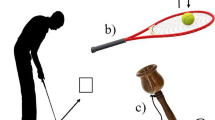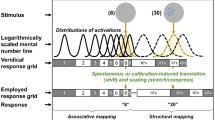Abstract
In the research literature several positions concerning the role played by metacognition in adaptive strategy choice can be distinguished. While many authors adhere so-called metacognitive models of strategy choice and strategy change, others have questioned the extent to which metacognitive factors are associated with strategy choice and task performance and have proposed alternative theoretical frameworks wherein strategy choices are described in terms of associative models. In the present article we report data coming from a larger research project on the development of children’s numerosity judgement strategies and skills. The experimental task involved judging numerosities of colored blocks presented in a rectangular grid. Participants were 59 second grade and 50 sixth grade children, whose strategic performance data — obtained by means of a systematic analysis of their response-time patterns — were compared with interview data collected at the end of the experiment. The major result of this comparison is that not only the children from the oldest age group, but also the children from the youngest age group showed clear evidence of metacognitive awareness and understanding of different aspects of their strategic performance.
Résumé
Dans la littérature, il existe plusieurs positionnements sur le rôle joué par la métacognition dans la sélection adaptative des stratégies. Si nombreux auteurs souscrivent aux soi-disants modèles métacognitifs de sélection des stratégies et de changement de stratégie, d’autres scientifiques ont mis en question la mesure dans laquelle des facteurs métacognitifs sont associés à la sélection des stratégies et la performance de la tâche et proposent d’autres cadres de référence théoriques alternatifs qui déterminent la sélection des stratégies comme des modèles associatifs. La présente article discute les données d’une étude plus étendue sur le développement chez enfants des stratégies et les aptitudes pour déterminer des quantités. La tâche de l’expérience consiste en déterminer un nombre de blocs colorés représentés dans une grille carrée. Les participants sont 59 élèves de la deuxième année (de l’école primaire) et 50 élèves de la sixième année, dont les résultats de la performance stratégique — déterminés par l’analyse systématique des séquences dans leurs temps de réaction — ont été comparés aux résultats des interrogations faites à la fin de l’expérience. Le résultat le plus important qui sort de cette comparaison est que aussi bien les enfants du groupe d’âge plus âgé, que ceux du groupe d’âge le plus jeune ont montré une nette conscience métacognitive et compréhension de différentes aspects de leur performance stratégique.
Similar content being viewed by others
References
Alexander, J.M., Carr, M., & Schwanenflugel, P.J. (1995). Development of metacognition in gifted children: Directions for future research.Developmental Review, 15, 1–37.
Alexander, J.M., & Schwanenflugel, P.J. (1996). Development of metacognitive concepts about thinking in gifted and nongifted children: Recent research.Learning and Individual Differences, 8, 305–325.
Baroody, A.J., & Tiilikainen, S.H. (2003). Two perspectives on addition development. In A.J. Baroody & A. Dowker (Eds.),The development of arithmetic concepts and skills (pp. 75–126). Mahwah, NJ: Lawrence Erlbaum Associates.
Beach, L.R., & Mitchell, T.R. (1978). A contingency model for the selection of decision strategies.Academy of Management Review, 3, 439–449.
Beem, A.L. (1993).Segcurve: A program for fitting two-phase segmented curve models with an unknown change point [Program manual]. Leiden, The Netherlands: Leiden University, Educational Computing Research Unit.
Beem, A.L. (1995). A program for fitting two-phase segmented curve models with an unknown change point, with an application to the analysis of strategy shifts in a cognitive task.Behavior Research Methods, Instruments, & Computers, 27, 392–399.
Beem, A.L., (1999).Segcurve: A program for fitting three-phase segmented curve models with two unknown change points [Program manual]. Amsterdam, The Netherlands: University of Amsterdam, Department of Biological Psychology.
Bray, N.W., Huffman, L.F., & Fletcher, K.L. (1999). Developmental and intellectual differences in self-report and strategy use.Developmental Psychology, 35, 1223–1236.
Cary, M., & Reder, L.M. (2002). Metacognition in strategy selection: Giving consciousness too much credit. In M. Izaute, P. Chambres, & P.J. Marescaux (Eds.),Metacognition: Process, function, and use (pp. 63–78). New York: Kluwer.
Cross, D.R., & Paris, S.G. (1988). Development and instructional analyses of children’s metacognition and reading comprehension.Journal of Educational Psychology, 80, 131–142.
Dehaene, S. (1992). Varieties of numerical abilities.Cognition, 44, 1–42.
Ericsson, K.A., & Simon, H. (1980). Verbal reports as data.Psychological Review, 87, 215–251.
Ericsson, K.A., & Simon, H. (1993).Protocol analysis. Verbal reports as data. Cambridge, MA: MIT Press.
Flavell, J.H., & Wellman, H.M. (1977). Metamemory. In R.V. Kail, & J.W. Hagen (Eds.),Perspectives on the development of memory and cognition (pp. 3–33). Hillsdale, NJ: Erlbaum.
Ippel, M.J., & Beem, A.L. (1987). A theory of antagonistic strategies. In E. De Corte, H. Lodewijks, R. Parmentier, & P. Span (Eds.),Learning and instruction: European research in an international context: Vol. 1 (pp. 111–121). Leuven: University Press.
Kilpatrick, J., Swafford, J., & Findell, B. (2001).Adding it up. Helping children learn mathematics Washington, DC: National Academy Press.
Kuhn, D. (1999). Metacognitive development. In L. Balter & C.S. Tamis-LeMonda (Eds.)Child psychology: A handbook of contemporary issues (pp. 259–286). Philadelphia: Psychology Press.
Kuhn, D., & Pearsall, S. (1998). Relations between metastrategic knowledge and strategic performance.Cognitive Development, 13, 227–247.
Kuhn, D., Garcia-Mila, M., Zohar, A., & Andersen, C. (1995). Strategies of knowledge acquisition.Society for Research in Child Development Monographs,60, (4) (Serial no. 245).
Lemaire, P., & Siegler, R.S. (1995). Four aspects of strategic change: Contributions to children’s learning of multiplication.Journal of Experimental Psychology: General, 124, 83–97.
Luwel, K., Beem, A.L., Onghena, P., & Verschaffel, L. (2001). Using segmented linear regression models with unknown change points to analyze strategy shifts in cognitive tasks.Behavior Research Methods, Instruments, & Computers, 33, 470–478.
Luwel, K., Verschaffel, L., Onghena, P., & De Corte, E. (2000). Children’s strategies for numerosity judgement in square grids of different sizes.Psychologica Belgica, 40, 183–209.
Luwel, K., Verschaffel, L., Onghena, P., & De Corte, E. (2001). Strategic aspects of children’s numerosity judgement.European Journal of Psychology of Education, 16, 233–255.
Payne, J.W., Bettman, J.R., & Johnson, E.J. (1993).The adaptive decision maker. Cambridge: University Press.
Schoenfeld, A.L. (1992). Learning to think mathematically. Problem solving, metacognition, and sense-making in mathematics. In D.A. Grouws (Ed.),Handbook of research in mathematics teaching and learning (pp. 334–370). New York: Macmillan.
Shrager, J., & Siegler, R.S. (1998). SCADS: A model of children’s strategy choices and strategy discoveries.Psychological Science, 9, 405–410.
Siegler, R.S. (1991). The microgenetic method: A direct means for studying cognitive development.American Psychologist, 46, 606–620.
Siegler, R.S. (1996).Emerging minds. The process of change in children’s thinking. New York: Oxford University Press.
Siegler, R.S., & Shipley, C. (1995). Variation, selection and cognitive change. In T. Simon & G. Halford (Eds.),Developing cognitive competence: New approaches to process modelling (pp. 31–76). Hillsdale, NJ: Erlbaum.
Siegler, R.S., & Shrager, J. (1984). Strategy choices in addition and subtraction: How do children know what to do? In C. Sophian (Ed.)Origins of cognitive skills. Hillsdale, NJ: Erlbaum.
Simons, R.J. (1996). Metacognition. In: E. De Corte & F. Weinert (Eds.),International encyclopedia of developmental and instructional psychology (pp. 441–444). Oxford: Pergamon.
Verschaffel, L., De Corte, E., Lamote, C., & Dhert, N. (1998). The acquisition and use of an adaptive strategy for estimating numerosity.European Journal of Psychology of Education, 13, 347–370.
Wynn, K. (1995). Origins of numerical knowledge.Mathematical Cognition, 1, 35–60.
Author information
Authors and Affiliations
Rights and permissions
About this article
Cite this article
Luwel, K., Torbeyns, J. & Verschaffel, L. The relation between metastrategic knowledge, strategy use and task performance: Findings and reflections from a numerosity judgement task. Eur J Psychol Educ 18, 425–447 (2003). https://doi.org/10.1007/BF03173245
Received:
Revised:
Issue Date:
DOI: https://doi.org/10.1007/BF03173245




